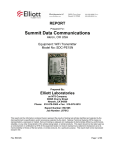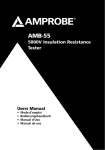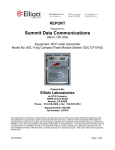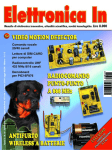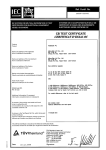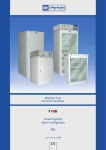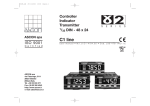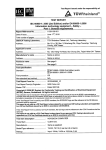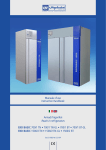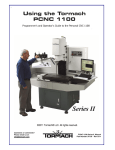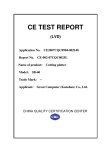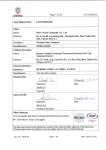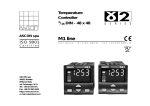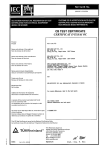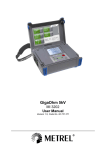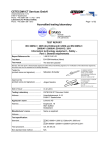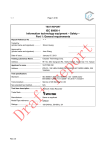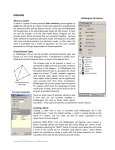Download TEST REPORT IEC 60950-1: 2005 (2nd Edition
Transcript
Test Report issued under the responsibility of: TEST REPORT IEC 60950-1: 2005 (2nd Edition) and/or EN 60950-1:2006 Information technology equipment – Safety – Part 1: General requirements Report Reference No...................... : ARSK00076/s Date of issue..................................... : 2010-05-12 Total number of pages ...................... 41 and No. 1 Annex CB/CCA Testing Laboratory .......... : IMQ S.p.A. Address ............................................ : Via Quintiliano 43, I-20138 Milano Applicant’s name............................ : Micro Device S.r.l. Address ............................................ : Via Bellini, 31/33 – I-20095 Cusano Milanino (MI) - ITALY Manufacturer’s name ..................... : Micro Device S.r.l. Address ............................................ : Via Bellini, 31/33 – I-20095 Cusano Milanino (MI) - ITALY Factory’s name ............................... : Micro Device S.r.l. Address ............................................ : Via Bellini, 31/33 – I-20095 Cusano Milanino (MI) - ITALY Test specification: nd Standard ........................................... : IEC 60950-1:2005 (2 Edition) and/or EN 60950-1:2006 Test procedure ................................. : / Non-standard test method…………..: N/A Test Report Form No...................... : IECEN60950_1C Test Report Form(s) Originator ........ : SGS Fimko Ltd Master TRF ...................................... : Dated 2007-06 Copyright © 2007 IEC System for Conformity Testing and Certification of Electrical Equipment (IECEE), Geneva, Switzerland. All rights reserved. This publication may be reproduced in whole or in part for non-commercial purposes as long as the IECEE is acknowledged as copyright owner and source of the material. IECEE takes no responsibility for and will not assume liability for damages resulting from the reader’s interpretation of the reproduced material due to its placement and context. If this Test Report Form is used by non-IECEE members, the IECEE/IEC logo and the reference to the CB Scheme procedure shall be removed. This report is not valid as a CB Test Report unless signed by an approved CB Testing Laboratory and appended to a CB Test Certificate issued by an NCB in accordance with IECEE 02. If this Test Report Form is used by non-CCA members, the CIG logo and the reference to the CCA Procedure shall be removed. This report is not valid as a CCA Test Report unless signed by an approved CCA Testing Laboratory and appended to a CCA Test Certificate issued by an NCB in accordance with CCA Test item description .....................: RADIOCONTROL Trade Mark ....................................... : MICRO DEVICE; YACHT CONTROLLER Manufacturer .................................... : MICRO DEVICE Model/Type reference....................... : DUAL BAND Ratings ............................................. : Transmitter Portable unit: 3 x 1,5 V Alkaline battery Receiver Fixed unit: DC 12÷24 V TRF No. IECEN60950_1D Page 3 of 41 Report No.: ARSK00076/s Summary of testing: Tests performed (name of test and test clause): Testing location: All the relevant tests of the following clause: • Via Quintiliano, 43, - I-20138 Milano • Viale Lombardia, 20 – I-20021 Bollate • • • • • • • • • • • • 1 GENERAL 2.2 SELV circuits 2.10 Clearances, creepage distances and distances through insulation 3.1 WIRING, CONNECTIONS AND SUPPLY 3.3 Wiring terminals for connection of external conductors 3.5 Interconnection of equipment 4 PHYSICAL REQUIREMENTS 4.2 echanical strength 4.3 Design and construction 4.5 Thermal requirements 4.7 Resistance to fire 5.3 Abnormal operating and fault conditions Summary of compliance with National Differences: CENELEC common modifications Copy of marking plate TRF No. IECEN60950_1D Page 4 of 41 Report No.: ARSK00076/s Test item particulars .................................................. : Equipment mobility .................................................... : [X] movable [] hand-held [] transportable [X] stationary [] for building-in [] direct plug-in Connection to the mains............................................ : [] pluggable equipment [] type A [] type B [X] permanent connection (on the vehicle) [] detachable power supply cord [] non-detachable power supply cord [] not directly connected to the mains Operating condition ................................................... : [] continuous [X] rated operating / resting time: duty cycle < 1% in 1 hour Access location ......................................................... : [X] operator accessible (transmitter unit) [X] restricted access location (receiver unit) Over voltage category (OVC) ................................... : [] OVC I [] other: [] OVC II [] OVC III [] OVC IV Mains supply tolerance (%) or absolute mains supply Transmitter unit: 3 x 1,5 V Alkaline battery values ....................................................................... : Receiver unit: DC 12÷24 V ± 5 % Tested for IT power systems .................................... : [] Yes [X] No IT testing, phase-phase voltage (V) .......................... : Class of equipment ................................................... : [] Class I [] Class II [] Not classified [X] Class III Considered current rating (A) ................................... : N/A Pollution degree (PD) ............................................... : [] PD 1 [X] PD 2 [] PD 3 IP protection class .................................................... : IPXX Altitude during operation (m) .................................... : Less than 2000 m s.l.m. Altitude of test laboratory (m) ................................... : 120 ± 15 % m s.l.m. Mass of equipment (kg) ............................................ : TX: 145 g; RX: 680 g; Possible test case verdicts: - test case does not apply to the test object..................: N/A - test object does meet the requirement .......................: P (Pass) - test object does not meet the requirement .................: F (Fail) Testing ..........................................................................: Date of receipt of test item ............................................: 2010-03-31 No. of .B.E.M. (IMQ reference number) : 53669 & 53784 Date(s) of performance of tests ....................................: 2010-04-19 ÷ 2010-04-29 TRF No. IECEN60950_1D Page 5 of 41 Report No.: ARSK00076/s General remarks: The test results presented in this report relate only to the object tested. This report shall not be reproduced, except in full, without the written approval of the Issuing testing laboratory. “(See Enclosure #)” refers to additional information appended to the report. “(See appended table)” refers to a table appended to the report. Note: This TRF includes EN Group Differences together with National Differences and Special National Conditions, if any. All Differences are located in the Appendix to the main body of this TRF. Throughout this report a comma (point) is used as the decimal separator. The uncertainties for the tests and measurements are those listed in IMQ Operational Instruction IO-LAB001. Engineering considerations: The equipment is an Radiocontrol for nautical use; it is composed by a portable unit, with internal Radio transmitter module AUR.EL at 433,92 MHz mod. TX-4M10HA & transmitter module AUR.EL at 868,30 MHz mod. TX-8LAVSA05, and a fixed unit with internal Radio receiver module AUR.EL at 433,92 MHz RXAM4SF & receiver module AUR.EL at 868,30 MHz mod. RX-AM8SF. Maximum ambient temperature considered: 70 °C. Conditions of acceptability: This Radio module equipment is incomplete in constructional features and so its acceptability as a field installed component can not be warranted. It is intended solely as a factory installed component of other equipment were the acceptability is to be determined by a Recognized Certification Body. The following items must be evaluated in the end use application: 1) An overall fire enclosure must be provided; 2) An Isolated safety extra low voltage (SELV) must be used to supply the equipment . 3) Temperatures should be spot checked. Models and Variants: All models electrically and mechanical are similar, the only difference are stated in the next Table: MODEL (basic) DUAL BAND Radiocontrol for nautical use with internal transmitter/receiver units working at 433,92 & 868,30 MHz. VARIANTS No variants Consideration on the above items: None. TRF No. IECEN60950_1D Page 6 of 41 Report No.: ARSK00076/s IEC/EN 60950-1 Clause Requirement + Test 1 GENERAL 1.5 Components P 1.5.1 General P 1.5.2 Result - Remark Verdict Comply with IEC 60950-1 or relevant component standard (see appended table 1.5.1) P Evaluation and testing of components Certified components are used in accordance with their certified ratings and they comply with applicable parts of EN 60950-1. P Components not certified are used in accordance with their ratings and they comply with applicable parts of EN 60950-1. Components, for which no relevant IEC or EN standards exist, have been tested under the conditions occurring in the equipment. 1.5.3 Thermal controls N/A 1.5.4 Transformers N/A 1.5.5 Interconnecting cables 1.5.6 Capacitors bridging insulation N/A 1.5.7 Resistors bridging insulation N/A 1.5.7.1 Resistors bridging functional, basic or supplementary insulation N/A 1.5.7.2 Resistors bridging double or reinforced insulation between a.c. mains and other circuits N/A 1.5.7.3 Resistors bridging double or reinforced insulation between a.c. mains and antenna or coaxial cable N/A 1.5.8 Components in equipment for IT power systems N/A 1.5.9 Surge suppressors 1.5.9.1 General P 1.5.9.2 Protection of VDRs P 1.5.9.3 Bridging of functional insulation by a VDR N/A 1.5.9.4 Bridging of basic insulation by a VDR N/A 1.5.9.5 Bridging of supplementary, double or reinforced insulation by a VDR N/A TRF No. IECEN60950_1D P Varistor CT1210K25G P Page 7 of 41 Report No.: ARSK00076/s IEC/EN 60950-1 Clause Requirement + Test Result - Remark Verdict 1.6 Power interface 1.6.1 AC power distribution systems 1.6.2 Input current 1.6.3 Voltage limit of hand-held equipment N/A 1.6.4 Neutral conductor N/A 1.7 Marking and instructions 1.7.1 Power rating DC powered via vehicular battery P Rated voltage(s) or voltage range(s) (V) ............... : DC 12/24 V P N/A (see appended table 1.6.2) N/A Symbol for nature of supply, for d.c. only ............... : P Rated frequency or rated frequency range (Hz) .... : N/A Rated current (mA or A) ........................................ : Max. 250mA Manufacturer’s name or trade-mark or identification MICRO DEVICE mark ...................................................................... : Model identification or type reference ................... : DUAL BAND Symbol for Class II equipment only ....................... : Class III Other markings and symbols ................................ : P P P N/A P 1.7.2 Safety instructions and marking 1.7.2.1 General 1.7.2.2 Disconnect devices N/A 1.7.2.3 Overcurrent protective device N/A 1.7.2.4 IT power distribution systems N/A 1.7.2.5 Operator access with a tool 1.2.7.6 Ozone 1.7.3 Short duty cycles Restriction of operation according to ERC/REC 70-03: for equipment transmitting at 868,30 MHz, max duty cycle is < 1% in 1 hour; the manufacturer shall declared max duty cycle on user manual. 1.7.4 Supply voltage adjustment ................................... : EUT not intended for connection to multiple rated voltage TRF No. IECEN60950_1D See installation manual There are not operator access areas reachable by means of a tool. P N/A N/A P N/A Page 8 of 41 Report No.: ARSK00076/s IEC/EN 60950-1 Clause Requirement + Test Result - Remark Verdict Methods and means of adjustment; reference to installation instructions ......................................... : N/A 1.7.5 Power outlets on the equipment ........................... : N/A 1.7.6 Fuse identification (marking, special fusing characteristics, cross-reference) .......................... : 1.7.7 Wiring terminals 1.7.7.1 Protective earthing and bonding terminals ........... : 1.7.7.2 Terminals for a.c. mains supply conductors 1.7.7.3 Terminals for d.c. mains supply conductors See installation manual: brown for (+) and blu for (-) P 1.7.8 Controls and indicators There are no controls that affect the safety N/A 1.7.8.1 Identification, location and marking ...................... : P 1.7.8.2 Colours ................................................................ : P 1.7.8.3 Symbols according to IEC 60417 ......................... : N/A 1.7.8.4 Markings using figures ....................................... : N/A 1.7.9 Isolation of multiple power sources ..................... : N/A 1.7.10 Thermostats and other regulating devices .......... : 1.7.11 Durability 1.7.12 Removable parts RX unit: OK; TX unit: marking is placed on removable part that can not be replaced in such a way that the marking would become misleading. P 1.7.13 Replaceable batteries .......................................... : See user manual; the manufacturer declared that only alkaline batteries type AAA shall be used. P Language(s) ........................................................ : Operating and installation instructions are in the language of the country where the machine is marketed 1.7.14 Equipment for restricted access locations ........... : TRF No. IECEN60950_1D See installation manual and General connection diagram Class III P N/A N/A Not present N/A P N/A Page 9 of 41 Report No.: ARSK00076/s IEC/EN 60950-1 Clause Requirement + Test Result - Remark Verdict 2 PROTECTION FROM HAZARDS 2.1 Protection from electric shock and energy hazards 2.1.1 Protection in operator access areas No hazardous energized parts accessible by operator. N/A 2.1.1.1 Access to energized parts No hazardous energized parts. N/A Test by inspection ................................................. : N/A Test with test finger (Figure 2A) ............................ : N/A Test with test pin (Figure 2B) ................................ : N/A Test with test probe (Figure 2C) ............................ : N/A 2.1.1.2 Battery compartments No TNV circuit is present. N/A 2.1.1.3 Access to ELV wiring No internal ELV wiring is present in the appliance. N/A Working voltage (Vpeak or Vrms); minimum distance through insulation (mm) 2.1.1.4 Access to hazardous voltage circuit wiring No internal Hazardous voltage wiring 2.1.1.5 Energy hazards ..................................................... : Connectors for SELV circuit 2.1.1.6 Manual controls Not present 2.1.1.7 Discharge of capacitors in equipment P N/A N/A Measured voltage (V); time-constant (s) ................ : 2.1.1.8 N/A Energy hazards – d.c. mains supply N/A a) Capacitor connected to the d.c. mains supply .. : N/A b) Internal battery connected to the d.c. mains supply .................................................................... : N/A 2.1.1.9 Audio amplifiers ..................................................... : 2.1.2 Protection in service access areas N/A 2.1.3 Protection in restricted access locations N/A 2.2 SELV circuits 2.2.1 General requirements 2.2.2 Voltages under normal conditions (V) ................... : < 42.4 Vpeak or 60 Vdc. P 2.2.3 Voltages under fault conditions (V) ....................... : No accessible voltage exceeds the SELV limit even after a single fault. < 71 V peak or 120 V d.c. P TRF No. IECEN60950_1D See cl. 2.1.1.1 See separate test report IEC/EN 60065 N/A P Page 10 of 41 Report No.: ARSK00076/s IEC/EN 60950-1 Clause Requirement + Test Result - Remark Verdict 2.2.4 Connection of SELV circuits to other circuits ...... : SELV circuit N/A 2.3 TNV circuits 2.3.1 Limits Not present N/A Type of TNV circuits............................................... : 2.3.2 Separation from other circuits and from accessible parts N/A 2.3.2.1 General requirements N/A 2.3.2.2 Protection by basic insulation N/A 2.3.2.3 Protection by earthing N/A 2.3.2.4 Protection by other constructions .......................... : N/A 2.3.3 Separation from hazardous voltages N/A Insulation employed ............................................... : 2.3.4 Connection of TNV circuits to other circuits N/A Insulation employed ............................................... : 2.3.5 Test for operating voltages generated externally 2.4 Limited current circuits 2.4.1 General requirements 2.4.2 Limit values N/A Not present N/A N/A Frequency (Hz)....................................................... : Measured current (mA) .......................................... : Measured voltage (V) ............................................. : Measured circuit capacitance (nF or µF) ............... : 2.4.3 Connection of limited current circuits to other circuits 2.5 Limited power sources a) Inherently limited output N/A Not present N/A b) Impedance limited output N/A c) Regulating network limited output under normal operating and single fault condition N/A d) Overcurrent protective device limited output N/A Max. output voltage (V), max. output current (A), max. apparent power (VA) ..................................... : Current rating of overcurrent protective device (A) .: TRF No. IECEN60950_1D Page 11 of 41 Report No.: ARSK00076/s IEC/EN 60950-1 Clause Requirement + Test Result - Remark 2.6 Provisions for earthing and bonding 2.6.1 Protective earthing N/A 2.6.2 Functional earthing N/A 2.6.3 Protective earthing and protective bonding conductors N/A 2.6.3.1 General N/A 2.6.3.2 Size of protective earthing conductors N/A 2 Rated current (A), cross-sectional area (mm ), AWG ...................................................................... : 2.6.3.3 Verdict Size of protective bonding conductors N/A 2 Rated current (A), cross-sectional area (mm ), AWG ...................................................................... : Protective current rating (A), cross-sectional area 2 (mm ), AWG........................................................... : 2.6.3.4 Resistance of earthing conductors and their terminations; resistance (Ω), voltage drop (V), test current (A), duration (min) ...................................... : N/A 2.6.3.5 Colour of insulation ................................................ : N/A 2.6.4 Terminals N/A 2.6.4.1 General N/A 2.6.4.2 Protective earthing and bonding terminals N/A Rated current (A), type, nominal thread diameter (mm)....................................................................... : 2.6.4.3 Separation of the protective earthing conductor from protective bonding conductors N/A 2.6.5 Integrity of protective earthing N/A 2.6.5.1 Interconnection of equipment N/A 2.6.5.2 Components in protective earthing conductors and protective bonding conductors N/A 2.6.5.3 Disconnection of protective earth N/A 2.6.5.4 Parts that can be removed by an operator N/A 2.6.5.5 Parts removed during servicing N/A 2.6.5.6 Corrosion resistance N/A 2.6.5.7 Screws for protective bonding N/A 2.6.5.8 Reliance on telecommunication network or cable distribution system N/A TRF No. IECEN60950_1D Page 12 of 41 Report No.: ARSK00076/s IEC/EN 60950-1 Clause Requirement + Test Result - Remark 2.7 Overcurrent and earth fault protection in primary circuits 2.7.1 Basic requirements No primary circuit present Verdict N/A Instructions when protection relies on building installation N/A 2.7.2 Faults not simulated in 5.3.7 N/A 2.7.3 Short-circuit backup protection N/A 2.7.4 Number and location of protective devices ........... : N/A 2.7.5 Protection by several devices N/A 2.7.6 Warning to service personnel ................................ : N/A 2.8 Safety interlocks 2.8.1 General principles 2.8.2 Protection requirements N/A 2.8.3 Inadvertent reactivation N/A 2.8.4 Fail-safe operation N/A 2.8.5 Moving parts N/A 2.8.6 Overriding N/A 2.8.7 Switches and relays N/A 2.8.7.1 Contact gaps (mm) ................................................ : N/A 2.8.7.2 Overload test N/A 2.8.7.3 Endurance test N/A 2.8.7.4 Electric strength test 2.8.8 Mechanical actuators 2.9 Electrical insulation 2.9.1 Properties of insulating materials Insulation materials have adequate thermal and mechanical strength. 2.9.2 Humidity conditioning Performed for 48 h. Not present (see appended table 5.2) N/A N/A N/A Relative humidity (%), temperature (°C) .......... ..... : P N/A 2.9.3 Grade of insulation N/A 2.9.4 Separation from hazardous voltages N/A Method(s) used ..................................................... : 2.10 Clearances, creepage distances and distances through insulation TRF No. IECEN60950_1D Page 13 of 41 Report No.: ARSK00076/s IEC/EN 60950-1 Clause Requirement + Test Result - Remark 2.10.1 General Appliance supplied by SELV source. P 2.10.1.1 Frequency ............................................................. : DC P 2.10.1.2 Pollution degrees ................................................... : Pollution degree 2. P 2.10.1.3 Reduced values for functional insualtion N/A 2.10.1.4 Intervening unconnected conductive parts N/A 2.10.1.5 Insulation with varying dimensions N/A 2.10.1.6 Special separation requirements N/A 2.10.1.7 Insulation in circuits generating starting pulses N/A 2.10.2 Determination of working voltage 2.10.2.1 General P 2.10.2.2 RMS working voltage P 2.10.2.3 Peak working voltage P 2.10.3 Clearances P 2.10.3.1 General P 2.10.3.2 Mains transient voltages N/A a) AC mains supply ............................................... : N/A b) Earthed d.c. mains supplies .............................. : N/A c) Unearthed d.c. mains supplies .......................... : N/A d) Battery operation ............................................... : N/A The measured working voltage or the input voltage was applied, whatever value was higher. Verdict P 2.10.3.3 Clearances in primary circuits (see appended table 2.10.3 and 2.10.4) N/A 2.10.3.4 Clearances in secondary circuits (see appended table 2.10.3 and 2.10.4) P 2.10.3.5 Clearances in circuits having starting pulses (see appended table 2.10.3 and 2.10.4) N/A 2.10.3.6 Transients from a.c. mains supply ........................ : 2.10.3.7 Transients from d.c. mains supply ........................ : 2.10.3.8 Transients from telecommunication networks and cable distribution systems ..................................... : N/A 2.10.3.9 Measurement of transient voltage levels N/A a) Transients from a mains suplply N/A For an a.c. mains supply ....................................... : N/A For a d.c. mains supply ......................................... : N/A TRF No. IECEN60950_1D N/A Not present N/A Page 14 of 41 Report No.: ARSK00076/s IEC/EN 60950-1 Clause Requirement + Test Result - Remark b) Transients from a telecommunication network : Verdict N/A 2.10.4 Creepage distances P 2.10.4.1 General P 2.10.4.2 Material group and caomparative tracking index P CTI tests ................................................................. : Material group IIIb is assumed to be used 2.10.4.3 Minimum creepage distances (see appended table 2.10.3 and 2.10.4) P 2.10.5 Solid insulation N/A 2.10.5.1 General N/A 2.10.5.2 Distances through insulation 2.10.5.3 Insulating compound as solid insulation N/A 2.10.5.4 Semiconductor devices N/A 2.10.5.5. Cemented joints 2.10.5.6 Thin sheet material – General N/A 2.10.5.7 Separable thin sheet material N/A (see appended table 2.10.5) (see appended table 2.10.3 and 2.10.4) N/A N/A Number of layers (pcs) ........................................... : 2.10.5.8 Non-separable thin sheet material N/A 2.10.5.9 Thin sheet material – standard test procedure N/A Electric strength test 2.10.5.10 (see appended table 2.10.5) Thin sheet material – alternative test procedure Electric strength test N/A (see appended table 2.10.5) 2.10.5.11 Insulation in wound components N/A 2.10.5.12 Wire in wound components N/A Working voltage .................................................... : N/A a) Basic insulation not under stress ...................... : N/A b) Basic, supplemetary, reinforced insulation ........ : N/A c) Compliance with Annex U ................................. : N/A Two wires in contact inside wound component; angle between 45° and 90° ................................... : N/A Wire with solvent-based enamel in wound components N/A 2.10.5.13 Electric strength test 2.10.5.14 (see appended table 2.10.5) Routine test N/A Additional insulation in wound components N/A TRF No. IECEN60950_1D Page 15 of 41 Report No.: ARSK00076/s IEC/EN 60950-1 Clause Requirement + Test Result - Remark Verdict Working voltage .................................................... : N/A - Basic insulation not under stress ........................ : N/A - Supplemetary, reinforced insulation .................... : N/A 2.10.6 Construction of printed boards P 2.10.6.1 Uncoated printed boards (see appended table 2.10.3 and 2.10.4) P 2.10.6.2 Coated printed boards (see appended table 2.10.3 and 2.10.4) N/A 2.10.6.3 Insulation between conductors on the same inner surface of a printed board (see appended table 2.10.3 and 2.10.4) P 2.10.6.4 Insulation between conductors on different layers of a printed board P Distance through insulation P Number of insulation layers (pcs)........................... : P 2.10.7 Component external terminations 2.10.8 Tests on coated printed boards and coated components N/A 2.10.8.1 Sample preparation and preliminary inspection N/A 2.10.8.2 Thermal conditioning N/A 2.10.8.3 Electric strength test 2.10.8.4 Abrasion resistance test N/A 2.10.9 Thermal cycling N/A 2.10.10 Test for Pollution Degree 1 environment and insulating compound 2.10.11 Tests for semiconductor devices and cemented joints N/A 2.10.12 Enclosed and sealed parts N/A TRF No. IECEN60950_1D (see appended table 2.10.3 and 2.10.4) (see appended table 5.2) PD 2 P N/A N/A Page 16 of 41 Report No.: ARSK00076/s IEC/EN 60950-1 Clause Requirement + Test Result - Remark Verdict 3 WIRING, CONNECTIONS AND SUPPLY 3.1 General 3.1.1 Current rating and overcurrent protection 3.1.2 Protection against mechanical damage The wireways are smooth and free of sharp edges. P 3.1.3 Securing of internal wiring The internal wirings are secured in a manner to prevent undue displacement or damaging. P 3.1.4 Insulation of conductors N/A 3.1.5 Beads and ceramic insulators N/A 3.1.6 Screws for electrical contact pressure N/A 3.1.7 Insulating materials in electrical connections N/A 3.1.8 Self-tapping and spaced thread screws N/A 3.1.9 Termination of conductors N/A 10 N pull test N/A 3.1.10 Sleeving on wiring N/A 3.2 Connection to a mains supply 3.2.1 Means of connection N/A 3.2.1.1 Connection to an a.c. mains supply N/A 3.2.1.2 Connection to a d.c. mains supply 3.2.2 Multiple supply connections N/A 3.2.3 Permanently connected equipment N/A P The receiver unit is connected to a vehicle battery – See installation manual Number of conductors, diameter of cable and conduits (mm) ....................................................... : P 3.2.4 Appliance inlets N/A 3.2.5 Power supply cords N/A 3.2.5.1 AC power supply cords N/A Type ...................................................................... : 2 Rated current (A), cross-sectional area (mm ), AWG ..................................................................... : 3.2.5.2 DC power supply cords P 3.2.6 Cord anchorages and strain relief P Mass of equipment (kg), pull (N) .......................... : TRF No. IECEN60950_1D Page 17 of 41 Report No.: ARSK00076/s IEC/EN 60950-1 Clause Requirement + Test Result - Remark Verdict Longitudinal displacement (mm) ........................... : 3.2.7 Protection against mechanical damage P 3.2.8 Cord guards N/A Diameter or minor dimension D (mm); test mass (g) ............................................................................... : Radius of curvature of cord (mm) .......................... : 3.2.9 Supply wiring space N/A 3.3 Wiring terminals for connection of external conductors 3.3.1 Wiring terminals P 3.3.2 Connection of non-detachable power supply cords P 3.3.3 Screw terminals 3.3.4 Conductor sizes to be connected N/A Conductors are suitable for the application. Rated current (A), cord/cable type, cross-sectional 2 area (mm ) ............................................................. : 3.3.5 N/A Wiring terminal sizes N/A Rated current (A), type, nominal thread diameter (mm) ..................................................................... : 3.3.6 Wiring terminal design N/A 3.3.7 Grouping of wiring terminals N/A 3.3.8 Stranded wire N/A 3.4 Disconnection from the mains supply 3.4.1 General requirement 3.4.2 Disconnect devices 3.4.3 Permanently connected equipment N/A 3.4.4 Parts which remain energized N/A 3.4.5 Switches in flexible cords N/A 3.4.6 Number of poles – single-phase and d.c. equipment 3.4.7 Number of poles – three-phase equipment N/A 3.4.8 Switches as disconnect devices N/A 3.4.9 Plugs as disconnect devices N/A 3.4.10 Interconnected equipment N/A 3.4.11 Multiple power sources N/A TRF No. IECEN60950_1D See installation manual P P P Page 18 of 41 Report No.: ARSK00076/s IEC/EN 60950-1 Clause Requirement + Test Result - Remark Verdict 3.5 Interconnection of equipment 3.5.1 General requirements 3.5.2 Types of interconnection circuits ........................... : 3.5.3 ELV circuits as interconnection circuits N/A 3.5.4 Data ports for additional equipment N/A 4 PHYSICAL REQUIREMENTS 4.1 Stability P SELV/SELV P N/A Angle of 10° Unit mass < 7 Kg N/A Test force (N) ........................................................ : Not a floor-standing unit N/A 4.2 Mechanical strength 4.2.1 General P 4.2.2 Steady force test, 10 N P 4.2.3 Steady force test, 30 N P 4.2.4 Steady force test, 250 N P 4.2.5 Impact test On RX unit (fixed unit) P Fall test On TX unit (portable unit) P Swing test On TX unit (portable unit) P Drop test; height (mm) .......................................... : On TX unit (portable unit) P 4.2.6 1000mm ± 10mm 4.2.7 Stress relief test N/A 4.2.8 Cathode ray tubes N/A Picture tube separately certified ............................ : N/A 4.2.9 High pressure lamps N/A 4.2.10 Wall or ceiling mounted equipment; force (N) ....... : N/A 4.3 Design and construction 4.3.1 Edges and corners 4.3.2 Handles and manual controls; force (N) .............: N/A 4.3.3 Adjustable controls N/A 4.3.4 Securing of parts N/A TRF No. IECEN60950_1D Edges and corners of the appliance enclosure are adequately rounded and smoothed. P Page 19 of 41 Report No.: ARSK00076/s IEC/EN 60950-1 Clause Requirement + Test Result - Remark Verdict 4.3.5 Connection by plugs and sockets N/A 4.3.6 Direct plug-in equipment N/A Torque .................................................................. : Compliance with the relevant mains plug standard: N/A 4.3.7 Heating elements in earthed equipment N/A 4.3.8 Batteries N/A - Overcharging of a rechargeable battery N/A - Unintentional charging of a non-rechargeable battery P - Reverse charging of a rechargeable battery N/A - Excessive discharging rate for any battery N/A 4.3.9 Oil and grease N/A 4.3.10 Dust, powders, liquids and gases N/A 4.3.11 Containers for liquids or gases N/A 4.3.12 Flammable liquids ................................................ : N/A Quantity of liquid (l) .............................................. : N/A Flash point (°C) .................................................... : N/A 4.3.13 Radiation N/A 4.3.13.1 General N/A 4.3.13.2 Ionizing radiation N/A 4.3.13.3 Measured radiation (pA/kg) .................................. : Measured high-voltage (kV) ................................. : Measured focus voltage (kV) ............................... : CRT markings ...................................................... : Effect of ultraviolet (UV) radiation on materials N/A Part, property, retention after test, flammability classification ......................................................... : N/A 4.3.13.4 Human exposure to ultraviolet (UV) radiation ...... : N/A 4.3.13.5 Laser (including LEDs) N/A Laser class ........................................................... : 4.3.13.6 Other types ........................................................... : TRF No. IECEN60950_1D The EUT comply with the essntial requirement of 1999/05/CE R&TTE Directive P Page 20 of 41 Report No.: ARSK00076/s IEC/EN 60950-1 Clause Requirement + Test Result - Remark Verdict 4.4 Protection against hazardous moving parts 4.4.1 General 4.4.2 Protection in operator access areas ..................... : N/A 4.4.3 Protection in restricted access locations .............. : N/A 4.4.4 Protection in service access areas N/A 4.5 Thermal requirements 4.5.1 General P 4.5.2 Temperature tests P Normal load condition per Annex L ...................... : No moving parts are present. N/A 4.5.3 Temperature limits for materials (see appended table 4.5) P 4.5.4 Touch temperature limits (see appended table 4.5) P 4.5.5 Resistance to abnormal heat ............................... : No hazardus voltage present 4.6 Openings in enclosures 4.6.1 Top and side openings P Dimensions (mm) ................................................. : 4.6.2 Bottoms of fire enclosures Construction of the bottomm, dimensions (mm) .. : No openings N/A P 4.6.3 Doors or covers in fire enclosures N/A 4.6.4 Openings in transportable equipment P 4.6.4.1 Constructional design measures P Dimensions (mm) ................................................. : 4.6.4.2 Evaluation measures for larger openings N/A 4.6.4.3 Use of metallized parts N/A 4.6.5 Adhesives for constructional purposes N/A Conditioning temperature (°C), time (weeks)........ : 4.7 Resistance to fire 4.7.1 Reducing the risk of ignition and spread of flame TRF No. IECEN60950_1D P Page 21 of 41 Report No.: ARSK00076/s IEC/EN 60950-1 Clause Requirement + Test Result - Remark Method 1, selection and application of components wiring and materials Method 1. Obtained with the appropriate use of the components and materials. No critical temperature rises under the heating test. Method 2, application of all of simulated fault condition tests (see appended table 5.3) Verdict P N/A 4.7.2 Conditions for a fire enclosure 4.7.2.1 Parts requiring a fire enclosure 4.7.2.2 Parts not requiring a fire enclosure P 4.7.3 Materials P 4.7.3.1 General P 4.7.3.2 Materials for fire enclosures 4.7.3.3 Materials for components and other parts outside fire enclosures 4.7.3.4 Materials for components and other parts inside fire enclosures N.A 4.7.3.5 Materials for air filter assemblies N/A 4.7.3.6 Materials used in high-voltage components N/A TRF No. IECEN60950_1D N/A Components in secondary circuits. HB-UL 94 P P P Page 22 of 41 Report No.: ARSK00076/s IEC/EN 60950-1 Clause Requirement + Test Result - Remark Verdict 5 ELECTRICAL REQUIREMENTS AND SIMULATED ABNORMAL CONDITIONS 5.1 Touch current and protective conductor current N/A 5.1.1 General N/A 5.1.2 Configuration of equipment under test (EUT) N/A 5.1.2.1 Single connection to an a.c. mains supply N/A 5.1.2.2 Redundant multiple connections to an a.c. mains supply N/A 5.1.2.3 Simultaneous multiple connections to an a.c. mains supply N/A 5.1.3 Test circuit N/A 5.1.4 Application of measuring instrument N/A 5.1.5 Test procedure N/A 5.1.6 Test measurements N/A Supply voltage (V) ................................................ : Measured touch current (mA) .............................. : Max. allowed touch current (mA) ......................... : Measured protective conductor current (mA) ....... : Max. allowed protective conductor current (mA)... : 5.1.7 Equipment with touch current exceeding 3,5 mA N/A 5.1.7.1 General ................................................................. : N/A 5.1.7.2 Simultaneous multiple connections to the supply N/A 5.1.8 Touch currents to telecommunication networks and cable distribution systems and from telecommunication networks N/A 5.1.8.1 Limitation of the touch current to a telecommunication network or to a cable distribution system N/A 5.1.8.2 Supply voltage (V) ................................................ : Measured touch current (mA) .............................. : Max. allowed touch current (mA) ......................... : Summation of touch currents from telecommunication networks N/A a) EUT with earthed telecommunication ports ..... : N/A b) EUT whose telecommunication ports have no reference to protective earth N/A TRF No. IECEN60950_1D Page 23 of 41 Report No.: ARSK00076/s IEC/EN 60950-1 Clause Requirement + Test 5.2 Electric strength 5.2.1 General 5.2.2 Test procedure 5.3 Abnormal operating and fault conditions P 5.3.1 Protection against overload and abnormal operation (see appended table 5.3) P 5.3.2 Motors (see appended Annex B) N/A 5.3.3 Transformers (see appended Annex C) N/A 5.3.4 Functional insulation.............................................. : N/A 5.3.5 Electromechanical components N/A 5.3.6 Audio amplifiers in ITE ......................................... : N/A 5.3.7 Simulation of faults 5.3.8 Unattended equipment 5.3.9 Compliance criteria for abnormal operating and fault conditions 5.3.9.1 During the tests 5.3.9.2 After the tests TRF No. IECEN60950_1D Result - Remark Verdict N/A (see appended table 5.2) N/A N/A P N/A P No fire and deformations on enclosure P N/A Page 24 of 41 Report No.: ARSK00076/s IEC/EN 60950-1 Clause Requirement + Test Result - Remark 6 CONNECTION TO TELECOMMUNICATION NETWORKS N/A 6.1 Protection of telecommunication network service persons, and users of other equipment connected to the network, from hazards in the equipment N/A 6.1.1 Protection from hazardous voltages N/A 6.1.2 Separation of the telecommunication network from earth N/A 6.1.2.1 Requirements N/A (see appended table 5.2) Verdict Supply voltage (V) ................................................ : Current in the test circuit (mA) ........................... : 6.1.2.2 Exclusions ............................................................ : N/A 6.2 Protection of equipment users from overvoltages on telecommunication networks N/A 6.2.1 Separation requirements N/A 6.2.2 Electric strength test procedure N/A 6.2.2.1 Impulse test (see appended table 5.2) N/A 6.2.2.2 Steady-state test (see appended table 5.2) N/A 6.2.2.3 Compliance criteria N/A 6.3 Protection of the telecommunication wiring system from overheating N/A Max. output current (A) ........................................ : Current limiting method ........................................ : 7 CONNECTION TO CABLE DISTRIBUTION SYSTEMS N/A 7.1 General N/A 7.2 Protection of cable distribution system service persons, and users of other equipment connected to the system, from hazardous voltages in the equipment N/A 7.3 Protection of equipment users from overvoltages on the cable distribution system N/A 7.4 Insulation between primary circuits and cable distribution systems N/A 7.4.1 General N/A 7.4.2 Voltage surge test (see appended table 5.2) N/A 7.4.3 Impulse test (see appended table 5.2) N/A TRF No. IECEN60950_1D Page 25 of 41 Report No.: ARSK00076/s IEC/EN 60950-1 Clause Requirement + Test Result - Remark A ANNEX A, TESTS FOR RESISTANCE TO HEAT AND FIRE N/A A.1 Flammability test for fire enclosures of movable equipment having a total mass exceeding 18 kg, and of stationary equipment (see 4.7.3.2) N/A A.1.1 Samples ................................................................ : Wall thickness (mm) ............................................. : A.1.2 Conditioning of samples; temperature (°C) .......... : N/A A.1.3 Mounting of samples ............................................ : N/A A.1.4 Test flame (see IEC 60695-11-3) N/A Flame A, B, C or D ............................................... : Verdict A.1.5 Test procedure N/A A.1.6 Compliance criteria N/A Sample 1 burning time (s) ..................................... : Sample 2 burning time (s) ..................................... : Sample 3 burning time (s) ..................................... : A.2 Flammability test for fire enclosures of movable equipment having a total mass not exceeding 18 kg, and for material and components located inside fire enclosures (see 4.7.3.2 and 4.7.3.4) A.2.1 Samples, material ................................................. : Wall thickness (mm) ............................................. : A.2.2 Conditioning of samples; temperature (°C) ... ....... : N/A A.2.3 Mounting of samples ............................................ : N/A A.2.4 Test flame (see IEC 60695-11-4) N/A Flame A, B or C .................................................... : N/A A.2.5 Test procedure N/A A.2.6 Compliance criteria N/A A.2.7 Sample 1 burning time (s) ..................................... : Sample 2 burning time (s) ..................................... : Sample 3 burning time (s) ..................................... : Alternative test acc. To IEC 60695-11-5, cl. 5 and 9 N/A Sample 1 burning time (s) ..................................... : Sample 2 burning time (s) ..................................... : Sample 3 burning time (s) ..................................... : A.3 Hot flaming oil test (see 4.6.2) N/A A.3.1 Mounting of samples N/A TRF No. IECEN60950_1D Page 26 of 41 Report No.: ARSK00076/s IEC/EN 60950-1 Clause Requirement + Test Result - Remark Verdict A.3.2 Test procedure N/A A.3.3 Compliance criterion N/A B ANNEX B, MOTOR TESTS UNDER ABNORMAL CONDITIONS (see 4.7.2.2 and 5.3.2) N/A B.1 General requirements N/A Position ................................................................. : Manufacturer ........................................................ : Type ..................................................................... : Rated values ....................................................... : B.2 Test conditions N/A B.3 Maximum temperatures (see appended table 5.3) N/A B.4 Running overload test (see appended table 5.3) N/A B.5 Locked-rotor overload test N/A Test duration (days) ............................................. : Electric strength test: test voltage (V) .................. : B.6 Running overload test for d.c. motors in secondary circuits N/A B.6.1 General N/A B.6.2 Test procedure N/A B.6.3 Alternative test procedure N/A B.6.4 Electric strength test; test voltage (V) .................. : N/A B.7 Locked-rotor overload test for d.c. motors in secondary circuits N/A B.7.1 General N/A B.7.2 Test procedure N/A B.7.3 Alternative test procedure N/A B.7.4 Electric strength test; test voltage (V) ................. : N/A B.8 Test for motors with capacitors (see appended table 5.3) N/A B.9 Test for three-phase motors (see appended table 5.3) N/A B.10 Test for series motors Operating voltage (V) ........................................... : TRF No. IECEN60950_1D N/A Page 27 of 41 Report No.: ARSK00076/s IEC/EN 60950-1 Clause Requirement + Test C ANNEX C, TRANSFORMERS (see 1.5.4 and 5.3.3) Result - Remark Verdict N/A Position ................................................................. : Manufacturer ........................................................ : Type ..................................................................... : Rated values ....................................................... : Method of protection ............................................. : C.1 Overload test (see appended table 5.3) N/A C.2 Insulation (see appended table 5.2) N/A Protection from displacement of windings ............: N/A D ANNEX D, MEASURING INSTRUMENTS FOR TOUCH-CURRENT TESTS (see 5.1.4) N/A D.1 Measuring instrument N/A D.2 Alternative measuring instrument N/A E ANNEX E, TEMPERATURE RISE OF A WINDING (see 1.4.13) N/A F ANNEX F, MEASUREMENT OF CLEARANCES AND CREEPAGE DISTANCES (see 2.10 and Annex G) N/A G ANNEX G, ALTERNATIVE METHOD FOR DETERMINING MINIMUM CLEARANCES N/A G.1 Clearances N/A G.1.1 General N/A G.1.2 Summary of the procedure for determining minimum clearances N/A G.2 Determination of mains transient voltage (V) N/A G.2.1 AC mains supply .................................................. : N/A G.2.2 Earthed d.c. mains supplies ................................. : N/A G.2.3 Unearthed d.c. mains supplies ............................. : N/A G.2.4 Battery operation .................................................. : N/A G.3 Determination of telecommunication network transient voltage (V) ............................................. : N/A G.4 Determination of required withstand voltage (V) N/A G.4.1 Mains transients and internal repetitive peaks ..... : N/A G.4.2 Transients from telecommunication networks ..... : N/A TRF No. IECEN60950_1D Page 28 of 41 Report No.: ARSK00076/s IEC/EN 60950-1 Clause Requirement + Test Result - Remark Verdict G.4.3 Combination of transients N/A G.4.4 Transients from cable distribution systems N/A G.5 Measurement of transient voltages (V) N/A a) Transients from a mains supply N/A For an a.c. mains supply N/A For a d.c. mains supply N/A b) Transients from a telecommunication network N/A G.6 Determination of minimum clearances ................ : N/A H ANNEX H, IONIZING RADIATION (see 4.3.13) N/A J ANNEX J, TABLE OF ELECTROCHEMICAL POTENTIALS (see 2.6.5.6) N/A Metal(s) used ....................................................... : K ANNEX K, THERMAL CONTROLS (see 1.5.3 and 5.3.8) N/A K.1 Making and breaking capacity N/A K.2 Thermostat reliability; operating voltage (V) ......... : N/A K.3 Thermostat endurance test; operating voltage (V) .............................................................................. : N/A K.4 Temperature limiter endurance; operating voltage (V) ........................................................................ : N/A K.5 Thermal cut-out reliability N/A K.6 Stability of operation L ANNEX L, NORMAL LOAD CONDITIONS FOR SOME TYPES OF ELECTRICAL BUSINESS EQUIPMENT (see 1.2.2.1 and 4.5.2) N/A L.1 Typewriters N/A L.2 Adding machines and cash registers N/A L.3 Erasers N/A L.4 Pencil sharpeners N/A L.5 Duplicators and copy machines N/A L.6 Motor-operated files N/A L.7 Other business equipment N/A TRF No. IECEN60950_1D (see appended table 5.3) N/A Page 29 of 41 Report No.: ARSK00076/s IEC/EN 60950-1 Clause Requirement + Test Result - Remark M ANNEX M, CRITERIA FOR TELEPHONE RINGING SIGNALS (see 2.3.1) N/A M.1 Introduction N/A M.2 Method A N/A M.3 Method B N/A M.3.1 Ringing signal N/A M.3.1.1 Frequency (Hz) ..................................................... : M.3.1.2 Voltage (V) ........................................................... : M.3.1.3 Cadence; time (s), voltage (V) ............................. : M.3.1.4 Single fault current (mA) ...................................... : M.3.2 Tripping device and monitoring voltage ............... : N/A M.3.2.1 Conditions for use of a tripping device or a monitoring voltage N/A M.3.2.2 Tripping device N/A M.3.2.3 Monitoring voltage (V) .......................................... : N/A N ANNEX N, IMPULSE TEST GENERATORS (see 1.5.7.2, 1.5.7.3, 2.10.3.9, 6.2.2.1, 7.3.2, 7.4.3 and Clause G.5) N/A N.1 ITU-T impulse test generators N/A N.2 IEC 60065 impulse test generator N/A P ANNEX P, NORMATIVE REFERENCES Q ANNEX Q, Voltage dependent resistors (VDRs) (see 1.5.9.1) P a) Preferred climatic categories ........................... : -55°C; +125°C b) Maximum continuous voltage .......................... : VRMS: 25V; VDC: 31V Verdict N/A N/A c) Pulse current .................................................... : N/A R ANNEX R, EXAMPLES OF REQUIREMENTS FOR QUALITY CONTROL PROGRAMMES N/A R.1 Minimum separation distances for unpopulated coated printed boards (see 2.10.6.2) N/A R.2 Reduced clearances (see 2.10.3) N/A S ANNEX S, PROCEDURE FOR IMPULSE TESTING (see 6.2.2.3) N/A S.1 Test equipment N/A S.2 Test procedure N/A S.3 Examples of waveforms during impulse testing N/A TRF No. IECEN60950_1D Page 30 of 41 Report No.: ARSK00076/s IEC/EN 60950-1 Clause Requirement + Test Result - Remark T ANNEX T, GUIDANCE ON PROTECTION AGAINST INGRESS OF WATER (see 1.1.2) See separate test report U ANNEX U, INSULATED WINDING WIRES FOR USE WITHOUT INTERLEAVED INSULATION (see 2.10.5.4) See separate test report Verdict N/A N/A V ANNEX V, AC POWER DISTRIBUTION SYSTEMS (see 1.6.1) N/A V.1 Introduction N/A V.2 TN power distribution systems N/A W ANNEX W, SUMMATION OF TOUCH CURRENTS N/A W.1 Touch current from electronic circuits N/A W.1.1 Floating circuits N/A W.1.2 Earthed circuits N/A W.2 Interconnection of several equipments N/A W.2.1 Isolation N/A W.2.2 Common return, isolated from earth N/A W.2.3 Common return, connected to protective earth N/A X ANNEX X, MAXIMUM HEATING EFFECT IN TRANSFORMER TESTS (see clause C.1) N/A X.1 Determination of maximum input current N/A X.2 Overload test procedure N/A Y ANNEX Y, ULTRAVIOLET LIGHT CONDITIONING TEST (see 4.3.13.3) N/A Y.1 Test apparatus ..................................................... : N/A Y.2 Mounting of test samples : N/A Y.3 Carbon-arc light-exposure apparatus ................... : N/A Y.4 Xenon-arc light exposure apparatus .................... : N/A Z ANNEX Z, OVERVOLTAGE CATEGORIES (see 2.10.3.2 and Clause G.2) N/A AA ANNEX AA, MANDREL TEST (see 2.10.5.8) N/A BB ANNEX BB, CHANGES IN THE SECOND EDITION TRF No. IECEN60950_1D Page 31 of 41 Report No.: ARSK00076/s IEC/EN 60950-1 Clause Requirement + Test Result - Remark Verdict EN 60950-1:2006 – CENELEC COMMON MODIFICATIONS Contents Add the following annexes: P Annex ZA (normative) Normative references to international publications with their corresponding European publications Annex ZB (normative) Annex ZC (informative) General A-deviations Delete all the “country” notes in the reference document according to the following list: 1.4.8 1.5.8 2.2.3 2.3.2.1 2.7.1 3.2.1.1 4.3.6 4.7.3.1 6 6.2.2 7.1 G.2.1 1.3.Z1 Special national conditions Note 2 Note 2 Note Note 2 Note Note Note 1 & 2 Note 2 Note 2 & 5 Note 6. Note 3 Note 2 1.5.1 1.5.9.4 2.2.4 2.3.4 2.10.3.2 3.2.4 4.7 5.1.7.1 6.1.2.1 2.2.1 7.2 Annex H Note 2 & 3 Note Note Note 2 Note 2 Note 3. Note 4 Note 3 & 4 Note 2 Note 2 Note Note 2 1.5.7.1 1.7.2.1 2.3.2 2.6.3.3 2.10.5.13 2.5.1 4.7.2.2 5.3.7 6.1.2.2 6.2.2.2 7.3 Note Note 4, 5 & 6 Note Note 2 & 3 Note 3 Note 2 Note Note 1 Note Note Note 1 & 2 Add the following subclause: 1.3.Z1 P N Exposure to excessive sound pressure The apparatus shall be so designed and constructed as to present no danger when used for its intended purpose, either in normal operating conditions or under fault conditions, particularly providing protection against exposure to excessive sound pressures from headphones or earphones. NOTE Z1 A new method of measurement is described in EN 50332-1, Sound system equipment: Headphones and earphones associated with portable audio equipment – Maximum sound pressure level measurement methodology and limit considerations – Part 1: General method for “one package equipment”, and in EN 50332-2, Sound system equipment: Headphones and earphones associated with portable audio equipment – Maximum sound pressure level measurement methodology and limit considerations – Part 2: Guidelines to associate sets with headphones coming from different manufacturers. 1.5.1 Add the following NOTE: N/A NOTE Z1 The use of certain substances in electrical and electronic equipment is restricted within the EU: see Directive 2002/95/EC 1.7.2.1 Add the following NOTE: NOTE Z1 In addition, the instructions shall include, as far as applicable, a warning that excessive sound pressure from earphones and headphones can cause hearing loss TRF No. IECEN60950_1D N/A Page 32 of 41 Report No.: ARSK00076/s IEC/EN 60950-1 Clause Requirement + Test 2.7.1 Replace the subclause as follows: Result - Remark Verdict N/A Basic requirements To protect against excessive current, short-circuits and earth faults in PRIMARY CIRCUITS, protective devices shall be included either as integral parts of the equipment or as parts of the building installation, subject to the following, a), b) and c): a) except as detailed in b) and c), protective devices necessary to comply with the requirements of 5.3 shall be included as parts of the equipment; b) for components in series with the mains input to the equipment such as the supply cord, appliance coupler, r.f.i. filter and switch, short-circuit and earth fault protection may be provided by protective devices in the building installation; c) it is permitted for PLUGGABLE EQUIPMENT TYPE B or PERMANENTLY CONNECTED EQUIPMENT, to rely on dedicated overcurrent and short-circuit protection in the building installation, provided that the means of protection, e.g. fuses or circuit breakers, is fully specified in the installation instructions. If reliance is placed on protection in the building installation, the installation instructions shall so state, except that for PLUGGABLE EQUIPMENT TYPE A the building installation shall be regarded as providing protection in accordance with the rating of the wall socket outlet. 2.7.2 This subclause has been declared ‘void’. N/A 3.2.3 Delete the NOTE in Table 3A, and delete also in this table the conduit sizes in parentheses. N/A 3.2.5.1 Replace “60245 IEC 53” by “H05 RR-F”; “60227 IEC 52” by “H03 VV-F or H03 VVH2-F”; “60227 IEC 53” by “H05 VV-F or H05 VVH2-F2”. N/A In Table 3B, replace the first four lines by the following: | Up to and including 6 | | Over 6 up to and including 10 | | Over 10 up to and including 16 0,75 a) b) (0,75) c) | (1,0) | 1,0 | 1,5 | In the conditions applicable to Table 3B delete the words “in some countries” in a) condition . In NOTE 1, applicable to Table 3B, delete the second sentence. 3.3.4 In Table 3D, delete the fourth line: conductor sizes for 10 to 13 A, and replace with the following: | Over 10 up to and including 16 | 1,5 to 2,5 | P 1,5 to 4 | Delete the fifth line: conductor sizes for 13 to 16 A. 4.3.13.6 Add the following NOTE: NOTE Z1 Attention is drawn to 1999/519/EC: Council Recommendation on the limitation of exposure of the general public to electromagnetic fields 0 Hz to 300 GHz. Standards taking into account this Recommendation which demonstrate compliance with the applicable EU Directive are indicated in the OJEC. TRF No. IECEN60950_1D P Page 33 of 41 Report No.: ARSK00076/s IEC/EN 60950-1 Clause Requirement + Test Annex H Replace the last paragraph of this annex by: Result - Remark Verdict N/A At any point 10 cm from the surface of the OPERATOR ACCESS AREA, the dose rate shall not exceed 1 µSv/h (0,1 mR/h) (see NOTE). Account is taken of the background level. Replace the notes as follows: NOTE These values appear in Directive 96/29/Euratom. Delete NOTE 2. Bibliography Additional EN standards. ZA NORMATIVE REFERENCES TO INTERNATIONAL PUBLICATIONS WITH THEIR CORRESPONDING EUROPEAN PUBLICATIONS ZB SPECIAL NATIONAL CONDITIONS 1.2.4.1 In Denmark, certain types of Class I appliances (see 3.2.1.1) may be provided with a plug not establishing earthing conditions when inserted into Danish socket-outlets. N/A 1.5.7.1 In Finland, Norway and Sweden, resistors bridging BASIC INSULATION in CLASS I PLUGGABLE EQUIPMENT TYPE A must comply with the requirements in 1.5.7.2. N/A 1.5.8 In Norway, due to the IT power system used (see annex V, Figure V.7), capacitors are required to be rated for the applicable line-to-line voltage (230 V). N/A 1.5.9.4 In Finland, Norway and Sweden, the third dashed sentence is applicable only to equipment as defined in 6.1.2.2 of this annex. N/A 1.7.2.1 In Finland, Norway and Sweden, CLASS I PLUGGABLE EQUIPMENT TYPE A intended for connection to other equipment or a network shall, if safety relies on connection to protective earth or if surge suppressors are connected between the network terminals and accessible parts, have a marking stating that the equipment must be connected to an earthed mains socket-outlet. N/A The marking text in the applicable countries shall be as follows: In Finland: ”Laite on liitettävä suojamaadoituskoskettimilla varustettuun pistorasiaan” In Norway: “Apparatet må tilkoples jordet stikkontakt” In Sweden: “Apparaten skall anslutas till jordat uttag” 1.7.5 In Denmark, socket-outlets for providing power to other equipment shall be in accordance with the Heavy Current Regulations, Section 107-2-D1, Standard Sheet DK 1-3a, DK 1-5a or DK 1-7a, when used on Class I equipment. For STATIONARY EQUIPMENT the socket-outlet shall be in accordance with Standard Sheet DK 1-1b or DK 1-5a. N/A 2.2.4 In Norway, for requirements see 1.7.2.1, 6.1.2.1 and 6.1.2.2 of this annex. N/A 2.3.2 In Finland, Norway and Sweden there are additional requirements for the insulation. See 6.1.2.1 and 6.1.2.2 of this annex. N/A TRF No. IECEN60950_1D Page 34 of 41 Report No.: ARSK00076/s IEC/EN 60950-1 Clause Requirement + Test 2.3.4 In Norway, for requirements see 1.7.2.1, 6.1.2.1 and 6.1.2.2 of this annex. N/A 2.6.3.3 In the United Kingdom, the current rating of the circuit shall be taken as 13 A, not 16 A. N/A 2.7.1 In the United Kingdom, to protect against excessive currents and short-circuits in the PRIMARY CIRCUIT of DIRECT PLUG-IN EQUIPMENT, tests according to 5.3 shall be conducted, using an external protective device rated 30 A or 32 A. If these tests fail, suitable protective devices shall be included as integral parts of the DIRECT PLUG-IN EQUIPMENT, so that the requirements of 5.3 are met. N/A 2.10.5.13 In Finland, Norway and Sweden, there are additional requirements for the insulation, see 6.1.2.1 and 6.1.2.2 of this annex. N/A 3.2.1.1 In Switzerland, supply cords of equipment having a RATED CURRENT not exceeding 10 A shall be provided with a plug complying with SEV 1011 or IEC 60884-1 and one of the following dimension sheets: N/A SEV 6532-2.1991 Plug Type 15 SEV 6533-2.1991 Plug Type 11 SEV 6534-2.1991 Plug Type 12 Result - Remark Verdict 3P+N+PE 250/400 V, 10 A L+N 250 V, 10 A L+N+PE 250 V, 10 A In general, EN 60309 applies for plugs for currents exceeding 10 A. However, a 16 A plug and socket-outlet system is being introduced in Switzerland, the plugs of which are according to the following dimension sheets, published in February 1998: SEV 5932-2.1998 Plug Type 25 SEV 5933-2.1998 Plug Type 21 SEV 5934-2.1998 Plug Type 23 3.2.1.1 3L+N+PE 230/400 V, 16 A L+N 250 V, 16 A L+N+PE 250 V, 16 A In Denmark, supply cords of single-phase equipment having a rated current not exceeding13 A shall be provided with a plug according to the Heavy Current Regulations, Section 107-2-D1. N/A CLASS I EQUIPMENT provided with socket-outlets with earth contacts or which are intended to be used in locations where protection against indirect contact is required according to the wiring rules shall be provided with a plug in accordance with standard sheet DK 2-1a or DK 2-5a. If poly-phase equipment and single-phase equipment having a RATED CURRENT exceeding 13 A is provided with a supply cord with a plug, this plug shall be in accordance with the Heavy Current Regulations, Section 107-2-D1 or EN 60309-2. 3.2.1.1 In Spain, supply cords of single-phase equipment having a rated current not exceeding 10 A shall be provided with a plug according to UNE 20315:1994. Supply cords of single-phase equipment having a rated current not exceeding 2,5 A shall be provided with a plug according to UNE-EN 50075:1993. CLASS I EQUIPMENT provided with socket-outlets with earth contacts or which are intended to be used in locations where protection against indirect contact is required according to the wiring rules, shall be provided with a plug in accordance with standard UNE 20315:1994. If poly-phase equipment is provided with a supply cord with a plug, this plug shall be in accordance with UNE-EN 60309-2. TRF No. IECEN60950_1D N/A Page 35 of 41 Report No.: ARSK00076/s IEC/EN 60950-1 Clause Requirement + Test Result - Remark 3.2.1.1 In the United Kingdom, apparatus which is fitted with a flexible cable or cord and is designed to be connected to a mains socket conforming to BS 1363 by means of that flexible cable or cord and plug, shall be fitted with a ‘standard plug’ in accordance with Statutory Instrument 1768:1994 – The Plugs and Sockets etc. (Safety) Regulations 1994, unless exempted by those regulations. Verdict N/A NOTE ‘Standard plug’ is defined in SI 1768:1994 and essentially means an approved plug conforming to BS 1363 or an approved conversion plug. 3.2.1.1 In Ireland, apparatus which is fitted with a flexible cable or cord and is designed to be connected to a mains socket conforming to I.S. 411 by means of that flexible cable or cord and plug, shall be fitted with a 13 A plug in accordance with Statutory Instrument 525:1997 – National Standards Authority of Ireland (section 28) (13 A Plugs and Conversion Adaptors for Domestic Use) Regulations 1997. N/A 3.2.4 In Switzerland, for requirements see 3.2.1.1 of this annex. N/A 3.2.5.1 In the United Kingdom, a power supply cord with conductor of 1,25 mm2 is allowed for equipment with a rated current over 10 A and up to and including 13 A. N/A 3.3.4 In the United Kingdom, the range of conductor sizes of flexible cords to be accepted by terminals for equipment with a RATED CURRENT of over 10 A up to and including 13 A is: N/A 2 2 • 1,25 mm to 1,5 mm nominal cross-sectional area. 4.3.6 In the United Kingdom, the torque test is performed using a socket outlet complying with BS 1363 part 1:1995, including Amendment 1:1997 and Amendment 2:2003 and the plug part of DIRECT PLUG-IN EQUIPMENT shall be assessed to BS 1363: Part 1, 12.1, 12.2, 12.3, 12.9, 12.11, 12.12, 12.13, 12.16 and 12.17, except that the test of 12.17 is performed at not less than 125 °C. Where the metal earth pin is replaced by an Insulated Shutter Opening Device (ISOD), the requirements of clauses 22.2 and 23 also apply. N/A 4.3.6 In Ireland, DIRECT PLUG-IN EQUIPMENT is known as plug similar devices. Such devices shall comply with Statutory Instrument 526:1997 – National Standards Authority of Ireland (Section 28) (Electrical plugs, plug similar devices and sockets for domestic use) Regulations, 1997. N/A 5.1.7.1 In Finland, Norway and Sweden TOUCH CURRENT measurement results exceeding 3,5 mA r.m.s. are permitted only for the following equipment: N/A • STATIONARY PLUGGABLE EQUIPMENT TYPE A that ○ is intended to be used in a RESTRICTED ACCESS LOCATION where equipotential bonding has been applied, for example, in a telecommunication centre; and ○ has provision for a permanently connected PROTECTIVE EARTHING CONDUCTOR; and ○ is provided with instructions for the installation of that conductor by a SERVICE PERSON; • STATIONARY PLUGGABLE EQUIPMENT TYPE B; • STATIONARY PERMANENTLY CONNECTED EQUIPMENT. TRF No. IECEN60950_1D Page 36 of 41 Report No.: ARSK00076/s IEC/EN 60950-1 Clause Requirement + Test Result - Remark 6.1.2.1 In Finland, Norway and Sweden, add the following text between the first and second paragraph of the compliance clause: Verdict N/A If this insulation is solid, including insulation forming part of a component, it shall at least consist of either - two layers of thin sheet material, each of which shall pass the electric strength test below, or - one layer having a distance through insulation of at least 0,4 mm, which shall pass the electric strength test below. If this insulation forms part of a semiconductor component (e.g. an optocoupler), there is no distance through insulation requirement for the insulation consisting of an insulating compound completely filling the casing, so that CLEARANCES and CREEPAGE DISTANCES do not exist, if the component passes the electric strength test in accordance with the compliance clause below and in addition - passes the tests and inspection criteria of 2.10.11 with an electric strength test of 1,5 kV multiplied by 1,6 (the electric strength test of 2.10.10 shall be performed using 1,5 kV), and - is subject to ROUTINE TESTING for electric strength during manufacturing, using a test voltage of 1,5 kV. It is permitted to bridge this insulation with a capacitor complying with EN 132400:1994, subclass Y2. A capacitor classified Y3 according to EN 132400:1994, may bridge this insulation under the following conditions: - the insulation requirements are satisfied by having a capacitor classified Y3 as defined by EN 132400, which in addition to the Y3 testing, is tested with an impulse test of 2,5 kV defined in EN 60950-1:2006, 6.2.2.1; - the additional testing shall be performed on all the test specimens as described in EN 132400; - the impulse test of 2,5 kV is to be performed before the endurance test in EN 132400, in the sequence of tests as described in EN 132400. 6.1.2.2 In Finland, Norway and Sweden, the exclusions are applicable for PERMANENTLY CONNECTED EQUIPMENT, PLUGGABLE EQUIPMENT TYPE B and equipment intended to be used in a RESTRICTED ACCESS LOCATION where equipotential bonding has been applied, e.g. in a telecommunication centre, and which has provision for a permanently connected PROTECTIVE EARTHING CONDUCTOR and is provided with instructions for the installation of that conductor by a SERVICE PERSON. N/A 7.2 In Finland, Norway and Sweden, for requirements see 6.1.2.1 and 6.1.2.2 of this annex. N/A The term TELECOMMUNICATION NETWORK in 6.1.2 being replaced by the term CABLE DISTRIBUTION SYSTEM. 7.3 In Norway and Sweden, there are many buildings where the screen of the coaxial cable is normally not connected to the earth in the building installation. N/A 7.3 In Norway, for installation conditions see EN 60728-11:2005. N/A TRF No. IECEN60950_1D Page 37 of 41 Report No.: ARSK00076/s IEC/EN 60950-1 Clause Requirement + Test Result - Remark ZC A-DEVIATIONS (informative) 1.5.1 Sweden (Ordinance 1990:944) Verdict N/A Add the following: NOTE In Sweden, switches containing mercury are not permitted. 1.5.1 Switzerland (Ordinance on environmentally hazardous substances SR 814.081, Annex 1.7, Mercury – Annex 1.7 of SR 814.81 applies for mercury.) N/A Add the following: NOTE In Switzerland, switches containing mercury such as thermostats, relays and level controllers are not allowed. 1.7.2.1 N/A Denmark (Heavy Current Regulations) Supply cords of CLASS I EQUIPMENT, which is delivered without a plug, must be provided with a visible tag with the following text: Vigtigt! Lederen med grøn/gul isolation må kun tilsluttes en klemme mærket eller If essential for the safety of the equipment, the tag must in addition be provided with a diagram, which shows the connection of the other conductors, or be provided with the following text: “For tilslutning af de øvrige ledere, se medfølgende installationsvejledning.” 1.7.2.1 Germany (Gesetz über technische Arbeitsmittel und Verbraucherprodukte (Geräteund Produktsicherheitsgesetz – GPSG) [Law on technical labour equipment and th consumer products], of 6 January 2004, Section 2, Article 4, Clause (4), Item 2). N/A If for the assurance of safety and health certain rules during use, amending or maintenance of a technical labour equipment or readymade consumer product are to be followed, a manual in German language has to be delivered when placing the product on the market. Of this requirement, rules for use even only by SERVICE PERSONS are not exempted. 1.7.5 Denmark (Heavy Current Regulations) N/A With the exception of CLASS II EQUIPMENT provided with a socket outlet in accordance with the Heavy Current Regulations, Section 107-2-D1, Standard Sheet DK 1-4a, CLASS II EQUIPMENT shall not be fitted with socket-outlets for providing power to other equipment. 1.7.13 Switzerland (Ordinance on chemical hazardous risk reduction SR 814.81, Annex 2.15 Batteries) Annex 2.15 of SR 814.81 applies for batteries. N/A 5.1.7.1 Denmark (Heavy Current Regulations, Chapter 707, clause 707.4) N/A TOUCH CURRENT measurement results exceeding 3,5 mA r.m.s. are permitted only for PERMANENTLY CONNECTED EQUIPMENT and PLUGGABLE EQUIPMENT TYPE B. TRF No. IECEN60950_1D Page 38 of 41 Report No.: ARSK00076/s IEC/EN 60950-1 Clause Requirement + Test 1.5.1 TABLE: List of critical components Object/part No. U4 of receiver unit Manufacturer/ trademark MICROCHIP Result - Remark Type/model Technical data Verdict Standard (Edition / year) Mark(s) of 1 conformity ) PIC18F6720/67 / 22 / / U2 of transmitter MICROCHIP unit PIC16F886I/SO / / / Varistor V1 CT1210K25G / / / / 1 ) An asterisk indicates a mark which assures the agreed level of surveillance Supplementary information: none. 1.6.2 TABLE: Electrical data (in normal conditions) U (V) I (A) Irated (A) P (W) Fuse # Ifuse (A) Condition/status DC 12 0,080 / / External Min. 1 A DC 12 0,041 / / Internal PTC 1,25 A N°1 Output ON (with 4 Ω resistive load connected) The manufacturer declared on “Installation Manual” that it is necessary to install a fuse (min. 1A max. 2 A, not included in the kit) on this line. The manufacturer declared on “Installation Manual” that on output line “Bow Thruster, Stern Thruster & Anchor Winch, max. permissible DC current is 3 Ampere) Receiver in Stand-by DC 24 0,026 / / Internal PTC 1,25 A Receiver in Stand-by DC 4,5 0,014 / / / None Transmitter in transmitting mode Max. 2 A Supplementary information: TRF No. IECEN60950_1D Internal PTC 1,25 A Page 39 of 41 Report No.: ARSK00076/s IEC/EN 60950-1 Clause Requirement + Test Result - Remark 2.10.3 and 2.10.4 TABLE: Clearance and creepage distance measurements Clearance (cl) and creepage distance (cr) at/of/between: Verdict U peak (V) U r.m.s. (V) Required cl (mm) cl (mm) Required cr (mm) cr (mm) DC 24 V DC 24 V 0,2 > 0,2 0,04 > 0,04 Functional: PCB Basic/supplementary: Not Applicable Reinforced: Not applicable Supplementary information: none 4.5 TABLE: Thermal requirements Supply voltage (V) ........................... : RX unit TX unit DC 12 DC 4,5 Ambient Tmin (°C) ............................. : 22,0 22,0 Ambient Tmax (°C) ............................ : 22,0 22,0 Maximum measured temperature T of part/at:: Allowed Tmax (°C) T (°C) 1) Integrated U4 on receiver unit 30,5 100 2) Receiver module at 433,92 MHz 27,7 100 3) Receiver module at 868,30 MHz 28,1 100 4) Relay 23,3 100 5) Microprocessor of Anchor board 22,8 100 6) Integrated U2 on transmitter unit 22,0 100 7) Transmitter module at 433,92 MHz 22,0 100 8) Transmitter module at 868,30 MHz 22,1 100 9) PCB of transmitter portable unit 22,0 100 10) Batteries zone 22,0 100 Supplementary information: Temperature T of winding: / Supplementary information: TRF No. IECEN60950_1D t1 (°C) R1 (Ω) t2 (°C) R2 (Ω) T (°C) / / / / / Allowed Insulation class Tmax (°C) / / Page 40 of 41 Report No.: ARSK00076/s IEC/EN 60950-1 Clause Requirement + Test 4.5.5 TABLE: Ball pressure test of thermoplastic parts Result - Remark Verdict Allowed impression diameter (mm) .....................: ≤ 2 mm Part / Supplementary information: None TRF No. IECEN60950_1D Test temperature Impression diameter (mm) (°C) / / Page 41 of 41 Report No.: ARSK00076/s IEC/EN 60950-1 Clause Requirement + Test Result - Remark 5.3 TABLE: Fault condition tests Verdict Ambient temperature (°C) ....................................: 22,0 Power source for EUT: Manufacturer, model/type, output rating .........................................................: RX unit: DC 12 V TX unit: DC 4,5 V Component No. Fault Supply voltage (V) Test time Fuse # Fuse current (A) TX unit: S–c DC 4,5 10 min / - C6 & C9 capacitor Observation No hazard. Max temperatures recorded: D3 component (max. 130,8°C) Battery (max. 40,2°C) U2 and U4 component (max. 30°C) RX unit: S-c DC 12 1 min internal C4 Capacitor 1.25 RV4/ RV5 No hazard. Max temperatures recorded: C4 component (max. 23,5°C) FL1 component (max. 23,5°C) external 1 RV4/RV5 component (max. 23,5°C) V1 component (max. 23,5°C) U4 component (max. 23,5°C) Supplementary information: Immediately after the fault, RX unit ceases to function. List of test equipment used: Inv. No. Date System Power supply 6038A – Hewlett Packard S-03529 / Multimeter, FLUKE – 45 S-04159 05.2009 – 05.2010 Running alibre, Mauser, D/10 13494 S-00972 05.2008 – 05.2010 Micrometer, Mauser, 0.01 Gen. 1 25 S-00871 05.2008 – 05.2010 Dynamometer, CHATILLON, DDP-25 kg S-00874 02.2009 – 08.2010 Data acquisition unit, Fluke – IDRA S-02499 11.2009 – 11.2010 Oscilloscope, YOKOGAWA DL720 S-03745 05.2009 – 05.2010 Climatic Chamber, ANGELANTONI UY300 P-00484 05.2009 – 05.2011 TRF No. IECEN60950_1D Annex 1 Page 1 of 9 Report ref. No. ARSK00076/s TX DUAL BAND_TOP view TX DUAL BAND_INTERNAL view_top side Annex 1 Page 2 of 9 Report ref. No. ARSK00076/s TX DUAL BAND_INTERNAL view_bottom side TX DUAL BAND_QUARTZ & MICROCONTROLLER Annex 1 Page 3 of 9 TX DUAL BAND_RADIO MODULES TX DUAL BAND_BATTERIES Report ref. No. ARSK00076/s Annex 1 Page 4 of 9 RX DB/N_TOP view RX DB/N_REAR view Report ref. No. ARSK00076/s Annex 1 Page 5 of 9 Report ref. No. ARSK00076/s RX DB/N_INTERNAL view RX DB/N_INTERNAL view without modules Annex 1 Page 6 of 9 Report ref. No. ARSK00076/s RX DB/N_Power Supply module_Top view RX DB/N_Power Supply module_bottom view Annex 1 Page 7 of 9 Report ref. No. ARSK00076/s RX DB/N_Engine Output Board_Top view RX DB/N_Engine Output Board_Bottom view Annex 1 Page 8 of 9 Report ref. No. ARSK00076/s RX DB/N_Bow Thruster, Stern Thruster & Anchor Winch Output Board_Top view RX DB/N_Bow Thruster, Stern Thruster & Anchor Winch Output Board_Bottom view Annex 1 Page 9 of 9 Report ref. No. ARSK00076/s RX DB/N_Radio Receiver Module Board_Top view RX DB/N_Radio Receiver Module Board_Bottom view


















































